LINCOLN MKS 2016 Owners Manual
Manufacturer: LINCOLN, Model Year: 2016, Model line: MKS, Model: LINCOLN MKS 2016Pages: 382, PDF Size: 3.81 MB
Page 241 of 382
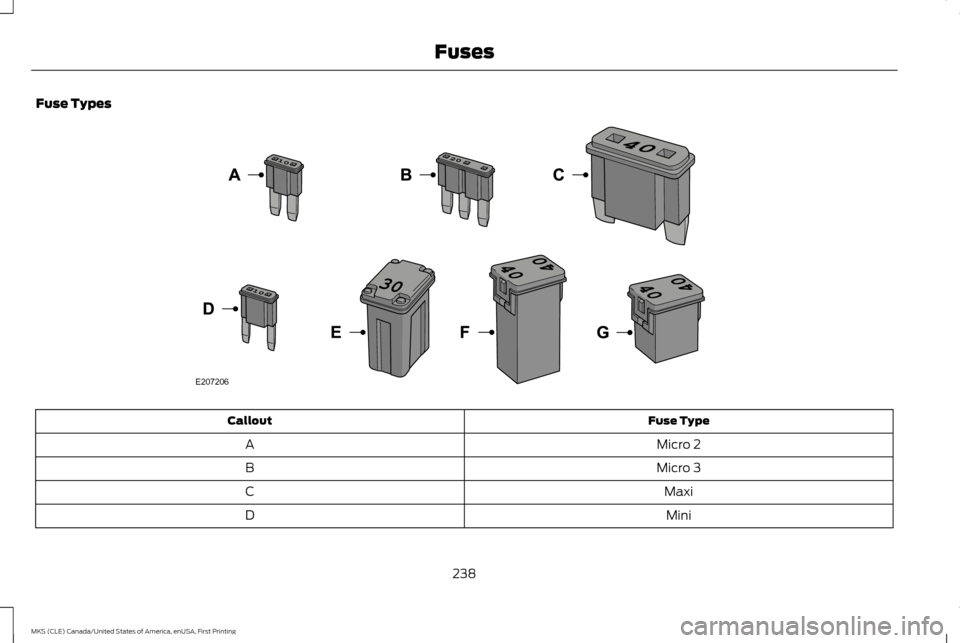
Fuse Types
Fuse Type
Callout
Micro 2
A
Micro 3
B
Maxi
C
Mini
D
238
MKS (CLE) Canada/United States of America, enUSA, First Printing FusesE207206
Page 242 of 382

Fuse Type
Callout
M Case
E
J Case
F
J Case Low Profile
G
239
MKS (CLE) Canada/United States of America, enUSA, First Printing Fuses
Page 243 of 382
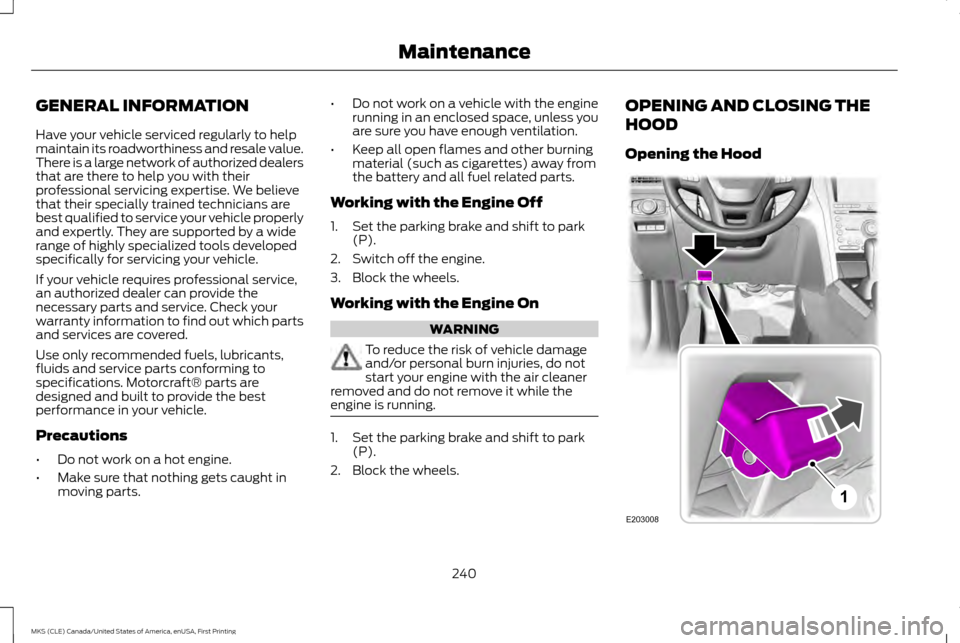
GENERAL INFORMATION
Have your vehicle serviced regularly to help
maintain its roadworthiness and resale value.
There is a large network of authorized dealers
that are there to help you with their
professional servicing expertise. We believe
that their specially trained technicians are
best qualified to service your vehicle properly
and expertly. They are supported by a wide
range of highly specialized tools developed
specifically for servicing your vehicle.
If your vehicle requires professional service,
an authorized dealer can provide the
necessary parts and service. Check your
warranty information to find out which parts
and services are covered.
Use only recommended fuels, lubricants,
fluids and service parts conforming to
specifications. Motorcraft® parts are
designed and built to provide the best
performance in your vehicle.
Precautions
•
Do not work on a hot engine.
• Make sure that nothing gets caught in
moving parts. •
Do not work on a vehicle with the engine
running in an enclosed space, unless you
are sure you have enough ventilation.
• Keep all open flames and other burning
material (such as cigarettes) away from
the battery and all fuel related parts.
Working with the Engine Off
1. Set the parking brake and shift to park (P).
2. Switch off the engine.
3. Block the wheels.
Working with the Engine On WARNING
To reduce the risk of vehicle damage
and/or personal burn injuries, do not
start your engine with the air cleaner
removed and do not remove it while the
engine is running. 1. Set the parking brake and shift to park
(P).
2. Block the wheels. OPENING AND CLOSING THE
HOOD
Opening the Hood
240
MKS (CLE) Canada/United States of America, enUSA, First Printing MaintenanceE203008
1
Page 244 of 382
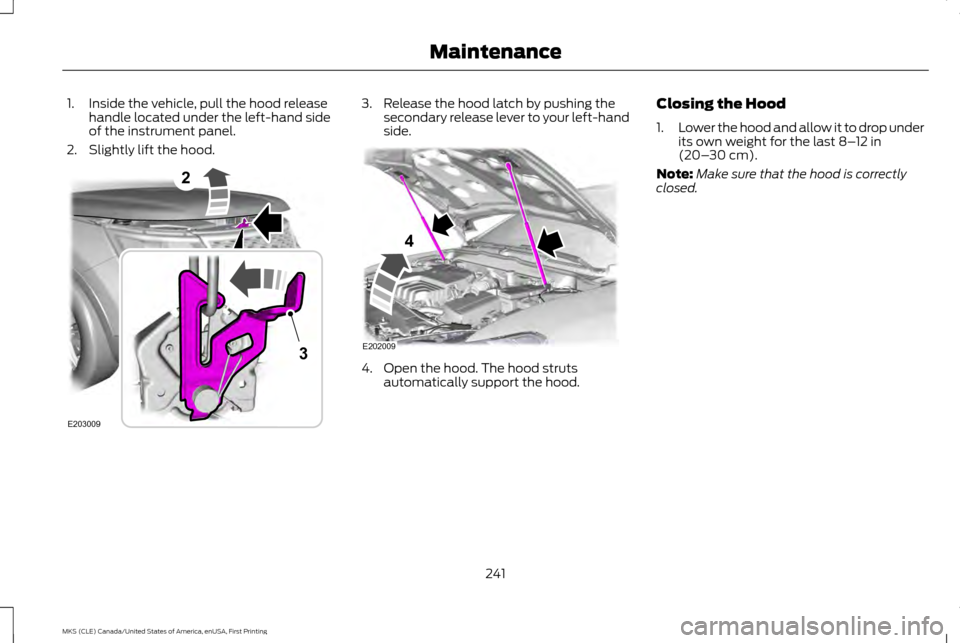
1. Inside the vehicle, pull the hood release
handle located under the left-hand side
of the instrument panel.
2. Slightly lift the hood. 3. Release the hood latch by pushing the
secondary release lever to your left-hand
side. 4. Open the hood. The hood struts
automatically support the hood. Closing the Hood
1.
Lower the hood and allow it to drop under
its own weight for the last 8–12 in
(20– 30 cm).
Note: Make sure that the hood is correctly
closed.
241
MKS (CLE) Canada/United States of America, enUSA, First Printing Maintenance2
E203009
3 E202009
4
Page 245 of 382

UNDER HOOD OVERVIEW - 3.5L ECOBOOST™
Engine coolant reservoir. See Engine Coolant Check (page 247).
A.
Engine oil filler cap. See
Engine Oil Check (page 245).
B.
242
MKS (CLE) Canada/United States of America, enUSA, First Printing MaintenanceE173375
Page 246 of 382
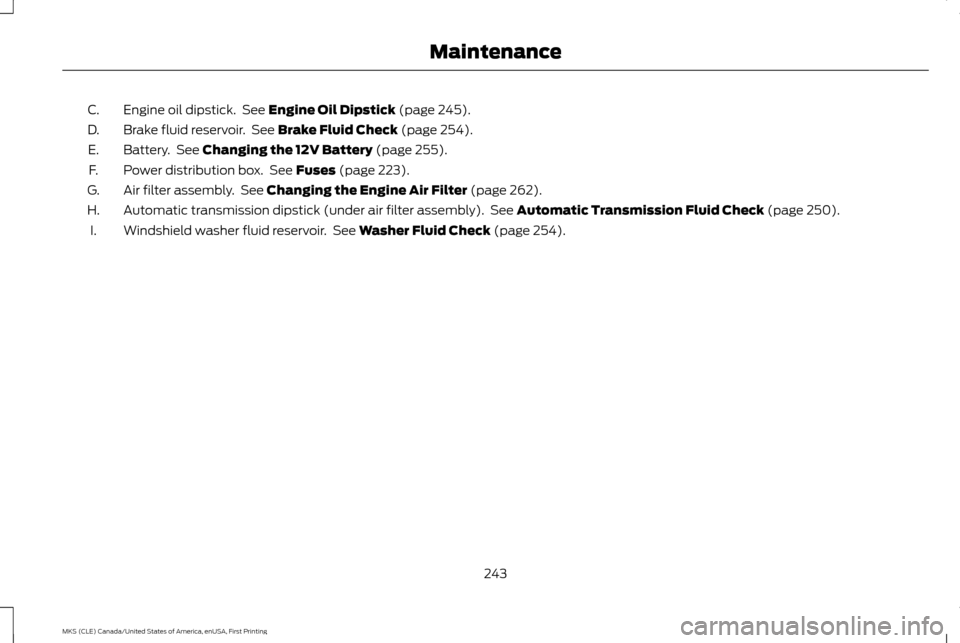
Engine oil dipstick. See Engine Oil Dipstick (page 245).
C.
Brake fluid reservoir. See
Brake Fluid Check (page 254).
D.
Battery. See
Changing the 12V Battery (page 255).
E.
Power distribution box. See
Fuses (page 223).
F.
Air filter assembly. See
Changing the Engine Air Filter (page 262).
G.
Automatic transmission dipstick (under air filter assembly). See
Automatic Transmission Fluid Check (page 250).
H.
Windshield washer fluid reservoir. See
Washer Fluid Check (page 254).
I.
243
MKS (CLE) Canada/United States of America, enUSA, First Printing Maintenance
Page 247 of 382

UNDER HOOD OVERVIEW - 3.7L
Engine coolant reservoir. See Engine Coolant Check (page 247).
A.
Engine oil filler cap. See
Engine Oil Check (page 245).
B.
Engine oil dipstick. See
Engine Oil Dipstick (page 245).
C.
Brake fluid reservoir. See
Brake Fluid Check (page 254).
D.
244
MKS (CLE) Canada/United States of America, enUSA, First Printing MaintenanceABCD
GHI
EF
E173333
Page 248 of 382
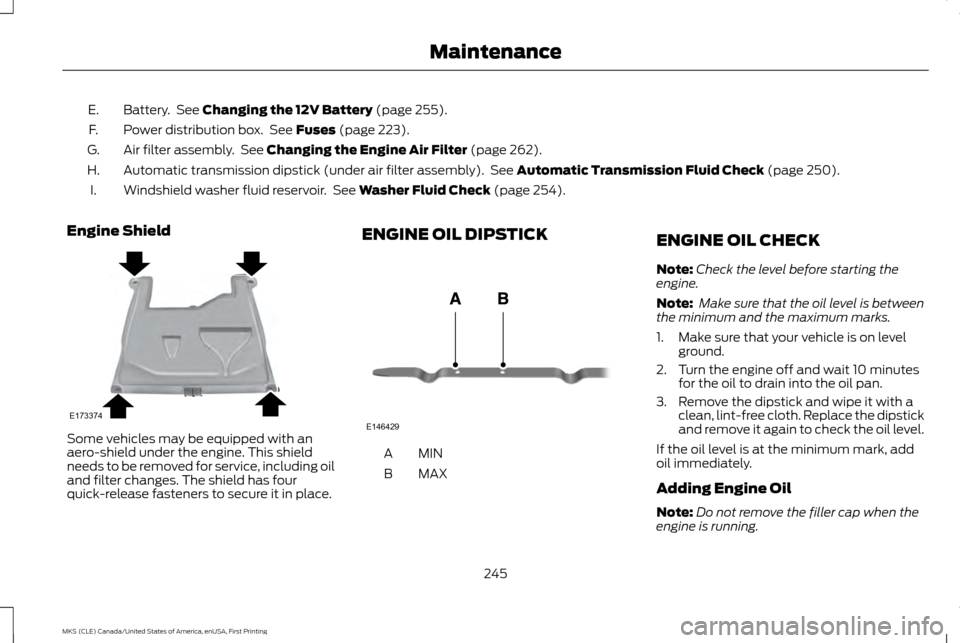
Battery. See Changing the 12V Battery (page 255).
E.
Power distribution box. See
Fuses (page 223).
F.
Air filter assembly. See
Changing the Engine Air Filter (page 262).
G.
Automatic transmission dipstick (under air filter assembly). See
Automatic Transmission Fluid Check (page 250).
H.
Windshield washer fluid reservoir. See
Washer Fluid Check (page 254).
I.
Engine Shield Some vehicles may be equipped with an
aero-shield under the engine. This shield
needs to be removed for service, including oil
and filter changes. The shield has four
quick-release fasteners to secure it in place. ENGINE OIL DIPSTICK
MINA
MAX
B ENGINE OIL CHECK
Note:
Check the level before starting the
engine.
Note: Make sure that the oil level is between
the minimum and the maximum marks.
1. Make sure that your vehicle is on level ground.
2. Turn the engine off and wait 10 minutes for the oil to drain into the oil pan.
3. Remove the dipstick and wipe it with a clean, lint-free cloth. Replace the dipstick
and remove it again to check the oil level.
If the oil level is at the minimum mark, add
oil immediately.
Adding Engine Oil
Note: Do not remove the filler cap when the
engine is running.
245
MKS (CLE) Canada/United States of America, enUSA, First Printing MaintenanceE173374 E146429
Page 249 of 382
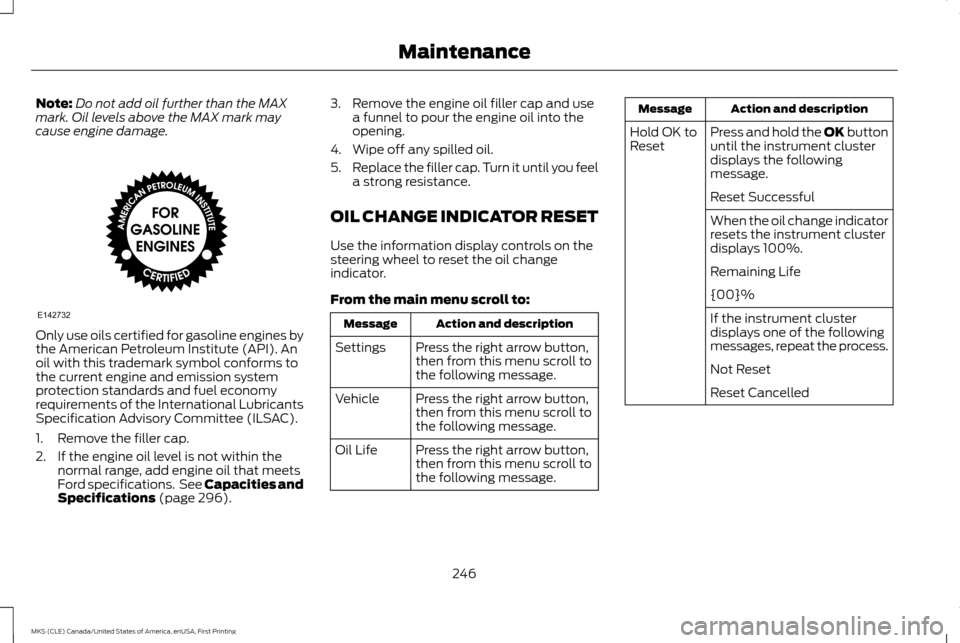
Note:
Do not add oil further than the MAX
mark. Oil levels above the MAX mark may
cause engine damage. Only use oils certified for gasoline engines by
the American Petroleum Institute (API). An
oil with this trademark symbol conforms to
the current engine and emission system
protection standards and fuel economy
requirements of the International Lubricants
Specification Advisory Committee (ILSAC).
1. Remove the filler cap.
2. If the engine oil level is not within the
normal range, add engine oil that meets
Ford specifications. See Capacities and
Specifications (page 296). 3. Remove the engine oil filler cap and use
a funnel to pour the engine oil into the
opening.
4. Wipe off any spilled oil.
5. Replace the filler cap. Turn it until you feel
a strong resistance.
OIL CHANGE INDICATOR RESET
Use the information display controls on the
steering wheel to reset the oil change
indicator.
From the main menu scroll to: Action and description
Message
Press the right arrow button,
then from this menu scroll to
the following message.
Settings
Press the right arrow button,
then from this menu scroll to
the following message.
Vehicle
Press the right arrow button,
then from this menu scroll to
the following message.
Oil Life Action and description
Message
Press and hold the
OK button
until the instrument cluster
displays the following
message.
Hold OK to
Reset
Reset Successful
When the oil change indicator
resets the instrument cluster
displays 100%.
Remaining Life
{00}%
If the instrument cluster
displays one of the following
messages, repeat the process.
Not Reset
Reset Cancelled
246
MKS (CLE) Canada/United States of America, enUSA, First Printing MaintenanceE142732
Page 250 of 382
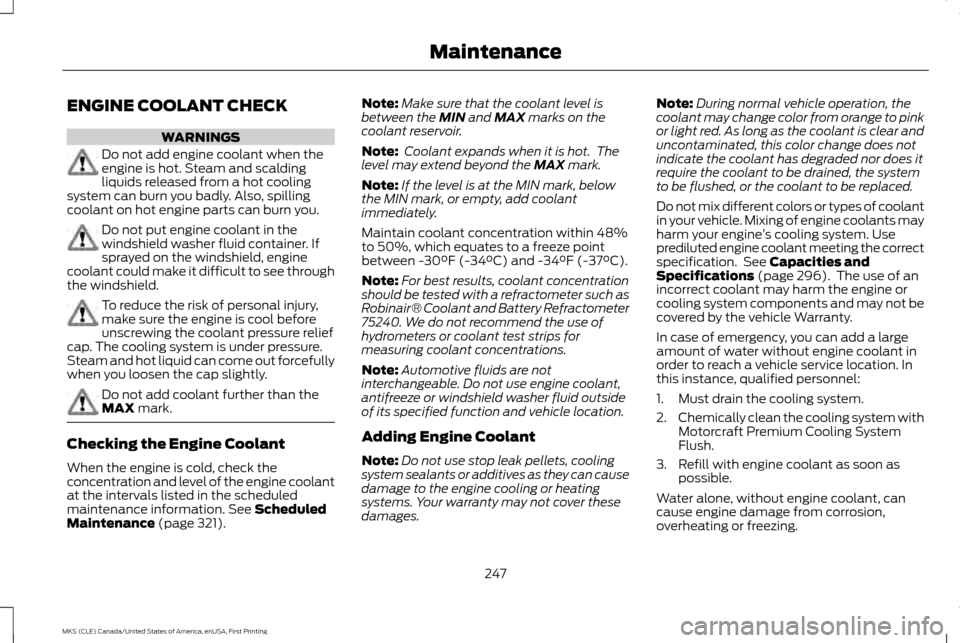
ENGINE COOLANT CHECK
WARNINGS
Do not add engine coolant when the
engine is hot. Steam and scalding
liquids released from a hot cooling
system can burn you badly. Also, spilling
coolant on hot engine parts can burn you. Do not put engine coolant in the
windshield washer fluid container. If
sprayed on the windshield, engine
coolant could make it difficult to see through
the windshield. To reduce the risk of personal injury,
make sure the engine is cool before
unscrewing the coolant pressure relief
cap. The cooling system is under pressure.
Steam and hot liquid can come out forcefully
when you loosen the cap slightly. Do not add coolant further than the
MAX mark.
Checking the Engine Coolant
When the engine is cold, check the
concentration and level of the engine coolant
at the intervals listed in the scheduled
maintenance information.
See Scheduled
Maintenance (page 321). Note:
Make sure that the coolant level is
between the
MIN and MAX marks on the
coolant reservoir.
Note: Coolant expands when it is hot. The
level may extend beyond the
MAX mark.
Note: If the level is at the MIN mark, below
the MIN mark, or empty, add coolant
immediately.
Maintain coolant concentration within 48%
to 50%, which equates to a freeze point
between -30°F (-34°C) and -34°F (-37°C).
Note: For best results, coolant concentration
should be tested with a refractometer such as
Robinair® Coolant and Battery Refractometer
75240. We do not recommend the use of
hydrometers or coolant test strips for
measuring coolant concentrations.
Note: Automotive fluids are not
interchangeable. Do not use engine coolant,
antifreeze or windshield washer fluid outside
of its specified function and vehicle location.
Adding Engine Coolant
Note: Do not use stop leak pellets, cooling
system sealants or additives as they can cause
damage to the engine cooling or heating
systems. Your warranty may not cover these
damages. Note:
During normal vehicle operation, the
coolant may change color from orange to pink
or light red. As long as the coolant is clear and
uncontaminated, this color change does not
indicate the coolant has degraded nor does it
require the coolant to be drained, the system
to be flushed, or the coolant to be replaced.
Do not mix different colors or types of coolant
in your vehicle. Mixing of engine coolants may
harm your engine ’s cooling system. Use
prediluted engine coolant meeting the correct
specification. See
Capacities and
Specifications (page 296). The use of an
incorrect coolant may harm the engine or
cooling system components and may not be
covered by the vehicle Warranty.
In case of emergency, you can add a large
amount of water without engine coolant in
order to reach a vehicle service location. In
this instance, qualified personnel:
1. Must drain the cooling system.
2. Chemically clean the cooling system with
Motorcraft Premium Cooling System
Flush.
3. Refill with engine coolant as soon as possible.
Water alone, without engine coolant, can
cause engine damage from corrosion,
overheating or freezing.
247
MKS (CLE) Canada/United States of America, enUSA, First Printing Maintenance